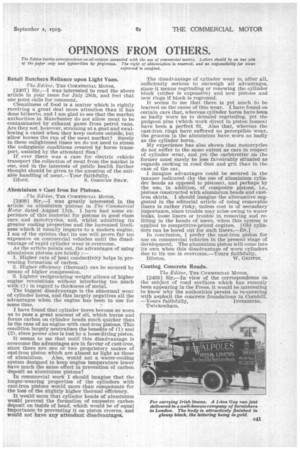Aluminium v Cast Iron for Pistons.
Page 25

If you've noticed an error in this article please click here to report it so we can fix it.
The Editor, THE COMMERCIAL MOTOR.
[2408] Sir,—I was greatly interested in the articleon aluminium pistons in The Commereiq Motor, dated August 11th. I have had some experience of this material for pistons in good class cars and motorcycles, and, whilst admitting its greater cooling properties and the increased liveliness which it usually imparts to a modern -engine, I am of the opinion that its use will prove far too expensive on commercial vehicles until the disadvantage of rapid cylinder wear is overcome.
As the article points out, the advantages of using aluminium pistons are briefly :— 1. Higher rate of heat conductivity helps in preventing formation of carbon.
2. Higher efficiency (thermal) can be secured by means of higher cOmpression.
3. Lighter reciprocating weight allows of higher engine revolutions without interfering too much with (1) in regard to thickness of metal.
The biggest disadvantage Is the abnormal wear of cylinder bores, and this largely negatives all the advantages when the engine has been in use for some time.
I have found that cylinder bores become so worn as to pass a great amount of oil, which burns and forms carbon on cylinder heads much quicker than in the case of an engine with cast-iron pistons. This condition largely neutralizes the benefits of (1) and (2), since power also is lost by a loose-fitting piston.
it seems to me that until this disadvantage Is overcome the advantages are in favour of cast-iron, since there are one or two proprietory makes of cast-iron piston which are almost as light as those of aluminium. Also, would not a water-cooling system designed to keep engine temperature lower have much the same effect in prevention of carbon deposit as aluminium pistons?
In commercial work I should imagine that the longer-wearing properties of the cylinders with cast-iron pistons would more than compensate for the loss of the slightly higher thermal efficiency.
It would seem that cylinder heads of aluminium would prevent the formation of excessive carbon deposit on inside of head, which would be of equal Importance to preventing it on piston crowns, and would not have any attendant disadvantages. The disadvantage of cylinder -wear is, after all, sufficiently serious to outweigh all advantages, since it means regrinding or renewing the cylinder block (either is expensive) and new pistons and new rings if block is reground.
It seems to me that there is yet much to be learned on the cause of this wear. I have found on certain ears that, whereas cylinder bores have been KO badly worn as to demand regrinding, yet the gudgeon pins (which work direct in piston bosses) have been a perfect fit. Also that, whereas the cast-iron rings have suffered no perceptible wear, the grooves in the aluminium have worn as badly as the cylinder bores.
My experience has also shown that Motorcycles do not suffer to the same extent as cars in respect of cylinder wear, and yet the carburetter on the former must surely be less favourably situated as regards sucking in road dust and grit than in the case of the ear.
• I imagine advantages could be secured in the manner indicated (by the use of aluminium cylinder heads as opposed to pistons), and perhaps by the use, in addition, of composite pistons, i.e., pistons constructed With aluminium heads and castiron skirts. I should imagine the alternative suggested in the editorial article of using removable liners is rather risky, unless cost is of secondary importance, since trouble may arise owing to water leaks, loose liners or trouble in removing and refitting in the hands of users, when this system is applied to competitive-priced engines. [Old cylinders can be bored out for such liners.—ED.] In conclusion, I prefer the cast-iron piston for use on commercial vehicles in the present stage of development. The aluminium piston will come into Its own when this disadvantage of worn cylinders due to its use is overcome.—Yours faithfully, Bilston. W. GRIFFIN.




























